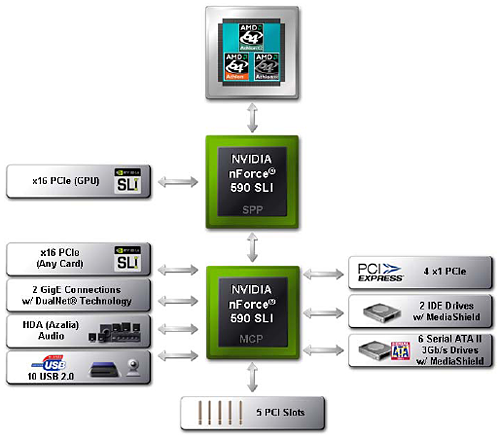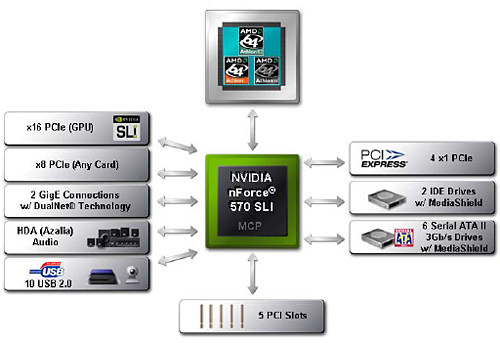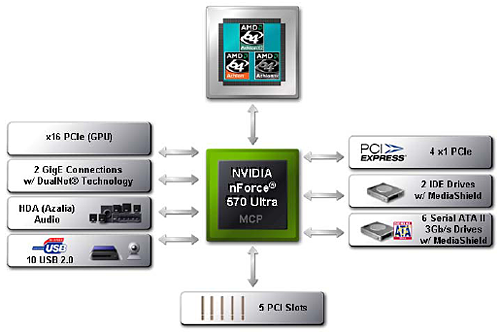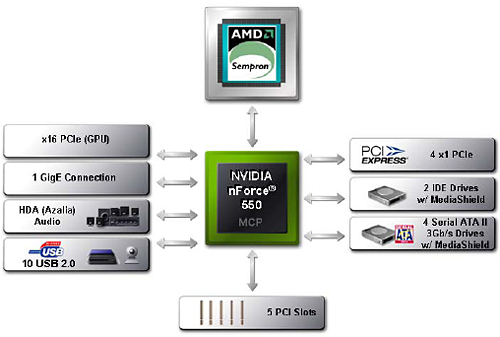nForce 500: nForce4 on Steroids?
by Gary Key & Wesley Fink on May 24, 2006 8:00 AM EST- Posted in
- CPUs
Basic Features: nForce 500 Platform
For the launch of socket AM2, NVIDIA is providing no less than four new product offerings dependent upon the market sector. With this product introduction NVIDIA is launching two new chipsets, the C51XE and MCP55PXE that form the basis for the four models. A quick summary of the new product choices can be found in the following table.| NVIDIA Chipset Breakdown | ||
| Market Segment | Socket 939 | Socket AM2 |
| High-End Enthusiast | nForce4 SLI X16 | nForce 590 SLI |
| Mainstream Enthusiast | nForce4 SLI | nForce 570 SLI |
| Performance Mainstream | nForce4 Ultra | nForce 570 Ultra |
| Value Mainstream | nForce4 4X | nForce 550 |
We expect the new socket AM2 motherboards to cost slightly more than their socket 939 counterparts, at least initially, but long-term they should have basically the same prices. The High-End Enthusiast segment will be around $200, Mainstream Enthusiast will be around $150, Performance Mainstream will be close to $100, and the Value Mainstream offerings will look to target the $80 or under market.

At the top of the product offering, the nForce 590 SLI consists of two chips, the C51Xe SPP and the MCP55PXE. This solution offers dual X16 PCI-E lanes for multiple graphics card configurations. While other features have changed, the overall design is very similar to the nForce4 SLI X16. The total number of PCI-E lanes is now 46, with 18 lanes coming from the SPP. Of those 18, two go unused at present and the remaining 16 are for the PEG slot.

One step down from the nForce 590 SLI is the nForce 570 SLI. This is a single chip solution, providing two X8 lanes for multiple graphics cards. A total of 28 lanes are of available, up from the 20 lanes that were available on the nForce4 SLI chipset. The 570 chipset also lacks the included LinkBoost technology but is otherwise the same as the 590.

The nForce 570 Ultra comes next, with a drop to 20 total PCI-E lanes. If the name didn't clue you in already, the Ultra also drops support for SLI. Basically, this is the "performance mainstream" offering, targeting users that are only interested in running single graphics cards. We do not expect a large difference in price between the 570 SLI and the 570 Ultra boards, and the $20 or so price premium might be worthwhile in order to have the extra PCI-E X16 slot. While at present only cards going into X16 slots are GPUs, depending on how long do you keep your next motherboard you might see additional options.

Rounding out the chipset offerings, the nForce 550 is the "value mainstream" product, taking over from the nForce4 4X. Several of the higher end options have been dropped from the 550 chipset, including support for dual Ethernet controllers, the FirstPacket technology, TCP/IP acceleration, and RAID 5. The number of natively supported SATA ports has also been reduced from six down to four. Whereas the other three chipsets are recommended for Athlon 64/FX/X2 users, the nForce 550 is recommended for Athlon 64 (single core) and Sempron users.
Here's a summary of the features and specifications of each chipset:
| Specification | |||||
| NVIDIA nForce 590 SLI |
NVIDIA nForce 4 SLI x16 |
NVIDIA nForce 570 SLI |
NVIDIA nForce 570 Ultra |
NVIDIA nForce 550 |
|
| Segment | Enthusiast SLI (2x16) |
Enthusiast SLI (2x16) |
Performance SLI (2x8) |
Performance | Mainstream |
| CPU Suggestion | Athlon 64 FX, Athlon 64 | Athlon 64 FX, Athlon 64 | Athlon 64 FX, Athlon 64 | Athlon 64 FX, Athlon 64 | Athlon 64, Sempron |
| SLI Technology | Yes | Yes | Yes | No | No |
| NVIDIA LinkBoost | Yes | No | No | No | No |
| NVIDIA FirstPacket | Yes | No | Yes | Yes | No |
| NVIDIA DualNet | Yes | No | Yes | Yes | No |
| Gigabit Connections | 2 | 2 - requires an external chipset | 2 | 2 | 1 |
| Teaming | Yes | No | Yes | Yes | No |
| TCP/IP Accleration | Yes | Yes, ActiveArmor | Yes | Yes | No |
| MediaShield | Yes | Yes | Yes | Yes | Yes |
| SATA / PATA Drives | 6 SATA 2 PATA |
4 SATA 4 PATA |
6 SATA 2 PATA |
6 SATA 2 PATA |
4 SATA 2 PATA |
| RAID | 0, 1, 0+1, 5 | 0, 1, 0+1 | 0, 1, 0+1, 5 | 0, 1, 0+1, 5 | 0, 1, 0+1 |
| NVIDIA nTune 5 | Yes | No | Yes | Yes | Yes |
| PCI Express Lanes | 46 | 38 | 28 | 20 | 20 |
| Links | 9 | 8 | 6 | 5 | 5 |
| USB Ports | 10 | 10 | 10 | 10 | 10 |
| PCI Slots Supported | 5 | 5 | 5 | 5 | 5 |
| Audio | Azalia | AC'97 | Azalia | Azalia | Azalia |










64 Comments
View All Comments
Olaf van der Spek - Wednesday, May 24, 2006 - link
<quote>These devices can be configured in RAID 0, 1, 0+1, and 5 arrays. There is no support for RAID 10.</quote>That's probably because there's effectively no difference between 1+0 and 0+1 on a good controller.
Olaf van der Spek - Wednesday, May 24, 2006 - link
Doesn't this require support from the modem/router too?
The delay (usually) happens in the modem and not in the network card.
Zoomer - Saturday, May 27, 2006 - link
No, because you make the bottleneck your network card, instead of the modem. :)There will be a slight loss of throughput. Read some QoS articles. lartc.org is also a good resource. I bet it's the same principle. ;)
Trisped - Wednesday, May 24, 2006 - link
<quote>Multiple computers can to be connected simultaneously </quote>http://www.anandtech.com/cpuchipsets/showdoc.aspx?...">http://www.anandtech.com/cpuchipsets/showdoc.aspx?...
take out the "to"
Gary Key - Wednesday, May 24, 2006 - link
Thanks, it is corrected.....Googer - Wednesday, May 24, 2006 - link
When benchmarking core logic it's should be a high priority to measure I/O performance, since that is the primary job of any AMD Chipset.Where are the HDD, Network, Audio, and R.A.I.D. benchmarks?
Gary Key - Wednesday, May 24, 2006 - link
I answered above but we will have full benchmarks in the actual motherboard articles. Our efforts in the first three days was to prove out the platform and features that were added or changed (still doing it, feels weird to be up almost 72 hours). In answer to your question-
Foxconn Board
Network-
Throughput - 942 Gb/s
CPU utilization - 14.37% (with TCP/IP offload engine on), near 30% off.
HDD/RAID
No real difference compared to nF4 as we stated. The numbers are within 1% of each other. The interesting numbers will be in our ATI SB600 comparison.
Audio-
Dependent on the codec utilized in each motherboard, the RealTek ALC883 used in most of them have the same numbers as the nF4 boards. The only difference is the new 1.37 driver set we used. It will be interesting in the comparison as Asus went back to ADI for HDA.
Pirks - Wednesday, May 24, 2006 - link
That's why AT is my favorite review site - 'cause you're really crazy bunch :-) Just don't ruin yourself completely, we need you!Gary Key - Wednesday, May 24, 2006 - link
The ending should read NF4 Intel or ATI/Uli AMD boards. Where is that edit function? Hit enter too soon. :)Gary Key - Wednesday, May 24, 2006 - link
They will be in our roundup comparison and ATI AM2 articles.